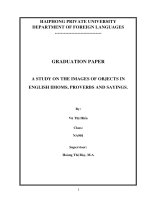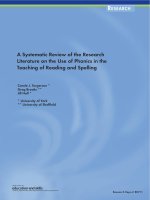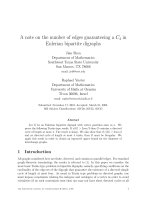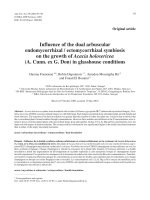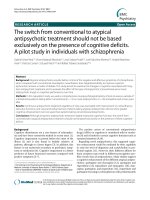On the sparsity of signals in a random sample
Bạn đang xem bản rút gọn của tài liệu. Xem và tải ngay bản đầy đủ của tài liệu tại đây (542.87 KB, 142 trang )
ON THE SPARSITY OF SIGNALS IN A
RANDOM SAMPLE
JIANG BINYAN
NATIONAL UNIVERSITY OF SINGAPORE
2011
ON THE SPARSITY OF SIGNALS IN A
RANDOM SAMPLE
JIANG BINYAN
(B.Sc. University of Science and Technology of China)
A THESIS SUBMITTED
FOR THE DEGREE OF DOCTOR OF PHILOSOPHY
DEPARTMENT OF STATISTICS AND APPLIED
PROBABILITY
NATIONAL UNIVERSITY OF SINGAPORE
2011
ii
ACKNOWLEDGEMENTS
I am so grateful that I have Professor Loh Wei-Liem as my supervisor. He
is truly a great mentor not only in statistics but also in daily life. I would like
to thank him for his guidance, encouragement, time, and endless patience. Next,
I would like to thank my senior Li Mengxin and Wang Daqing for discussion on
various topics in research. I also thank all my friends who helped me to make life
easier as a graduate student. I wish to express my gratitude to the university and
the department for supporting me through NUS Graduate Research Scholarship.
Finally, I will thank my family for their love and support.
iii
CONTENTS
Acknowledgements ii
Summary v
List of Notations vii
List of Tables viii
Chapter 1 Introduction 1
1.1 Signal detection . . . . . . . . . . . . . . . . . . . . . . . . . . . . . 4
1.2 Covariance selection . . . . . . . . . . . . . . . . . . . . . . . . . . 7
Chapter 2 Signal Detection 14
2.1 Introduction . . . . . . . . . . . . . . . . . . . . . . . . . . . . . . . 14
2.2 Trigonometric moment matrices . . . . . . . . . . . . . . . . . . . . 16
CONTENTS iv
2.3 A method-of-moments estimator when f
Z
is known . . . . . . . . . 19
2.4 The estimator of Lee, et al. (2010) . . . . . . . . . . . . . . . . . . 27
2.5 Lower bounds . . . . . . . . . . . . . . . . . . . . . . . . . . . . . . 29
2.6 A method-of-moments estimator when f
Z
is unknown . . . . . . . . 38
2.7 Numerical study . . . . . . . . . . . . . . . . . . . . . . . . . . . . . 42
Chapter 3 Covariance Selection 70
3.1 Introduction . . . . . . . . . . . . . . . . . . . . . . . . . . . . . . . 70
3.2 Sample correlation matrix . . . . . . . . . . . . . . . . . . . . . . . 72
3.3 Empirical Bayes e stimator under multivariate normal assumption . 81
3.3.1 Assumptions on the prior . . . . . . . . . . . . . . . . . . . 81
3.3.2 Motivation for ˆω
1
. . . . . . . . . . . . . . . . . . . . . . . . 84
3.3.3 Properties of ˆω
1
. . . . . . . . . . . . . . . . . . . . . . . . . 86
3.4 Method-of-moments estimator . . . . . . . . . . . . . . . . . . . . . 97
3.5 Numerical study . . . . . . . . . . . . . . . . . . . . . . . . . . . . . 113
Chapter 4 Conclusion 123
Bibliography 126
v
SUMMARY
The “large p small n” data sets are frequently encountered by various re-
searchers during the past decades. One of the commonly used assumptions for
these data sets is that the data set is sparse. Various methods have been devel-
oped in dealing with model selection, signal detection or large covariance matrix
estimation. However, as far as we know, the problem of estimating the “spar-
sity” has not been addressed thoroughly yet. Here loosely speaking, sparsity is
interpreted as the proportion of parameters taking the value 0.
Our work in this thesis contains two parts. The first part (Chapter 2) deals with
estimating the sparsity of a sparse random sequence. An estimator is constructed
from a sample analog of certain Hermitian trigonometric matrices. To evaluate our
estimator, upper and lower bounds for the minimax convergence rate are derived.
Summary vi
Simulation studies show that our estimator performs well.
The second part (Chapter 3) deals with estimating the sparsity of a large covari-
ance matrix or correlation matrix. This to some degree is related to the problem
of finding a universal data-dependent threshold for the elements of a sample corre-
lation matrix. We propose two estimators ˆω
1
and ˆω
2
based on different methods.
ˆω
1
is derived assuming that the observations X
1
, , X
n
are n independent random
samples from a multivariate normal distribution with mean 0
p
and unknown popu-
lation matrix Σ = (σ
ij
)
p×p
. In contrast, ˆω
2
is derived under more general (p ossibly
non-Gaussian) assumptions on the distribution of observations X
1
, , X
n
. Consis-
tency of these two estimators are proved under mild conditions. Simulation studies
are carried out with a comparison to thresholding estimators derived from cross
validation and adaptive cross validation methods.
vii
LIST Of NOTATIONS
0
p
p × 1 vector such that all elements are zero.
R
d
d-dimensional Euclidean space
C
d
d-dimensional complex space
M
transpose of a matrix M
a ∨ b maximum of a and b, where a, b ∈ R
a ∧ b minimum of a and b, where a, b ∈ R
· x denotes the largest integer less than or equal to
x ∈ R
I
{·}
indicator function
i
√
−1
viii
List of Tables
Table 2.1 Simulation results under the model P1 +N1:Nonzero Θ
i
= 3 and
Z
i
∼ N(0, 1). . . . . . . . . . . . . . . . . . . . . . . . . . . . . . . . 49
Table 2.2 Simulation results under the model P2 +N1:Nonzero Θ
i
= 5 and
Z
i
∼ N(0, 1). . . . . . . . . . . . . . . . . . . . . . . . . . . . . . . . 50
Table 2.3 Simulation results under the model P3+N1:Nonzero Θ
i
∼ N(0, 10)
and Z
i
∼ N(0, 1). . . . . . . . . . . . . . . . . . . . . . . . . . . . . . 51
List of Tables ix
Table 2.4 Simulation results under the model P4+N1:Nonzero Θ
i
∼ 10 exp(1)
and Z
i
∼ N(0, 1). . . . . . . . . . . . . . . . . . . . . . . . . . . . . . 52
Table 2.5 Simulation results under the model P5+N1:Nonzero Θ
i
∼ N(2, 1)
and Z
i
∼ N(0, 1). . . . . . . . . . . . . . . . . . . . . . . . . . . . . . 53
Table 2.6 Simulation results under the model P6+N1:Nonzero Θ
i
∼ exp(0.25)
and Z
i
∼ N(0, 1). . . . . . . . . . . . . . . . . . . . . . . . . . . . . . 54
Table 2.7 Simulation results under the model P7+N1:Nonzero Θ
i
∼ U(1, 1+
2π) and Z
i
∼ N(0, 1). . . . . . . . . . . . . . . . . . . . . . . . . . . 55
Table 2.8 Simulation results under the model P1 +N2:Nonzero Θ
i
= 3 and
Z
i
∼ t
5
/
5/3. . . . . . . . . . . . . . . . . . . . . . . . . . . . . . . 56
Table 2.9 Simulation results under the model P2 +N2:Nonzero Θ
i
= 5 and
Z
i
∼ t
5
/
5/3. . . . . . . . . . . . . . . . . . . . . . . . . . . . . . . 57
Table 2.10 Simulation results under the model P3+N2:Nonzero Θ
i
∼ N(0, 10)
and Z
i
∼ t
5
/
5/3. . . . . . . . . . . . . . . . . . . . . . . . . . . . . 58
Table 2.11 Simulation results under the model P4+N2:Nonzero Θ
i
∼ 10 exp(1)
and Z
i
∼ t
5
/
5/3. . . . . . . . . . . . . . . . . . . . . . . . . . . . . 59
List of Tables x
Table 2.12 Simulation results under the model P5+N2:Nonzero Θ
i
∼ N(2, 1)
and Z
i
∼ t
5
/
5/3. . . . . . . . . . . . . . . . . . . . . . . . . . . . . 60
Table 2.13 Simulation results under the model P6+N2:Nonzero Θ
i
∼ exp(0.25)
and Z
i
∼ t
5
/
5/3. . . . . . . . . . . . . . . . . . . . . . . . . . . . . 61
Table 2.14 Simulation results under the model P7+N2:Nonzero Θ
i
∼ U(1, 1+
2π) and Z
i
∼ t
5
/
5/3. . . . . . . . . . . . . . . . . . . . . . . . . . . 62
Table 2.15 Simulation results under the model P1 + N3:Nonzero Θ
i
= 3 and
Z
i
∼ SN (0, 1, 1)/
1 −1/π. . . . . . . . . . . . . . . . . . . . . . . . 63
Table 2.16 Simulation results under the model P2 +N3:Nonzero Θ
i
= 5 and
Z
i
∼ SN (0, 1, 1)/
1 −1/π. . . . . . . . . . . . . . . . . . . . . . . . 64
Table 2.17 Simulation results under the model P3+N3:Nonzero Θ
i
∼ N(0, 10)
and Z
i
∼ SN (0, 1, 1)/
1 −1/π. . . . . . . . . . . . . . . . . . . . . . 65
Table 2.18 Simulation results under the model P4+N3:Nonzero Θ
i
∼ 10 exp(1)
and Z
i
∼ SN (0, 1, 1)/
1 −1/π. . . . . . . . . . . . . . . . . . . . . . 66
Table 2.19 Simulation results under the model P5+N3:Nonzero Θ
i
∼ N(2, 1)
and Z
i
∼ SN (0, 1, 1)/
1 −1/π. . . . . . . . . . . . . . . . . . . . . . 67
List of Tables xi
Table 2.20 Simulation results under the model P6+N3:Nonzero Θ
i
∼ exp(0.25)
and Z
i
∼ SN (0, 1, 1)/
1 −1/π. . . . . . . . . . . . . . . . . . . . . . 68
Table 2.21 Simulation results under the model P7+N3:Nonzero Θ
i
∼ U(1, 1+
2π) and Z
i
∼ SN (0, 1, 1)/
1 −1/π. . . . . . . . . . . . . . . . . . . . 69
Table 3.1 Summary of simulation results over 100 replications under Model
1 when p = 50, ω=0.755102 and σ = 0.2. . . . . . . . . . . . . . . . . .
119
Table 3.2 Summary of simulation results over 100 replications under Model
1 when p = 100, ω=0.7525253 and σ = 0.2. . . . . . . . . . . . . . . . 119
Table 3.3 Summary of simulation results over 100 replications under Model
1 when p = 200, ω=0.7512563 and σ = 0.2. . . . . . . . . . . . . . . . 119
Table 3.4 Summary of simulation results over 100 replications under Model
1 when p = 50, ω=0.755102 and σ = 0.5. . . . . . . . . . . . . . . . . . 120
Table 3.5 Summary of simulation results over 100 replications under Model
1 when p = 100, ω=0.7525253 and σ = 0.5. . . . . . . . . . . . . . . . 120
Table 3.6 Summary of simulation results over 100 replications under Model
1 when p = 200, ω=0.7512563 and σ = 0.5. . . . . . . . . . . . . . . . 120
List of Tables xii
Table 3.7 Summary of simulation results over 100 replications under Model
2 when p = 50, ω=0.9306122. . . . . . . . . . . . . . . . . . . . . . . 121
Table 3.8 Summary of simulation results over 100 replications under Model
2 when p = 100, ω=0.8911111. . . . . . . . . . . . . . . . . . . . . . . 121
Table 3.9 Summary of simulation results over 100 replications under Model
2 when p = 200, ω=0.8125628. . . . . . . . . . . . . . . . . . . . . . . 121
Table 3.10 Summary of simulation results over 100 replications under Model
3.1, where ω = 0.7428571. . . . . . . . . . . . . . . . . . . . . . . . . 122
Table 3.11 Summary of simulation results over 100 replications under Model
3.2, where ω = 0.77111111. . . . . . . . . . . . . . . . . . . . . . . . . 122
Table 3.12 Summary of simulation results over 100 replications under Model
3.3, where ω = 0.8201005. . . . . . . . . . . . . . . . . . . . . . . . . 122
1
CHAPTER 1
Introduction
High dimension, low sample size (HDLSS) data sets are frequently encountered
nowadays in many different fields. However it is well known that the statistical
analysis of HDLSS data is very challenging and possibly intractable in some in-
stances. Fortunately in many situations, the data can be assumed to have some
particular structures. One of the commonly used assumptions of HDLSS data is
sparesness, and under this assumption, accurate statistical inference becomes fea-
sible. There are a lot of interesting problems in sparse HDLSS data analysis, and
here we mainly focus on two of these problems: (i) sparse signal detection and (ii)
sparse covariance selection.
2
For sparse signal detection problem, the sequence of observations X
1
, . . . , X
n
is usually modeled as X
i
= Θ
i
+ Z
i
, where Θ
1
, , Θ
n
is an unobservable signal
sequence and Z
1
, , Z
n
is a sequence of noise. T he objective of this problem is to
estimate the unobservable sparse signal sequence Θ
1
, , Θ
n
. For example, John-
stone and Silverman (2004) considered the estimation of sparse sequences observed
in Gaussian white noise. More precisely, the Z
i
’s are N(0, 1) random variables in-
dependent of the Θ
i
’s, and that the Θ
i
’s are sparse is modeled by using the prior
mixture density for Θ
i
: f
prior
(θ) = ω
0
δ
0
+ (1 − ω
0
)h(θ) where ω
0
∈ (0, 1] is a con-
stant, δ
0
denotes point mass at 0 and h is a density function. Sparsity is now
quantified by ω
0
, which is the proportion of θ
i
’s that are zero when n → ∞. In-
stead of finding estimators for the unobservable signal sequence, in this thesis we
are more interested in answering a relatively basic question: “How sparse is the
unobservable signal sequence (meaning how many of the θ
i
’s are 0)?” Or equiva-
lently, we are aiming at estimating ω
0
. Johnstone and Silverman (2004) used the
posterior median to estimate the signal sequence. Although the signal sequence
can be estimated quite well, according to our simulations, the resulting estimator is
usually not able to estimate ω
0
well unless ω
0
is close to 1. In fact, the problem of
estimating ω
0
has not been addressed a lot in the literature we have covered. In ad-
dition, in the literature, Z
1
, , Z
n
are usually assumed to be normally distributed.
It would be practically important to study the problem under more general noise
distributions.
3
The second problem is related to sparse covariance matrix estimation. The
problem of estimating a large sparse covariance matrix has generated much interest
in recent years. Here the literature is huge. This includes El Karoui (2008), Bickel
and Levina (2008a, b), Lam and Fan (2009), Cai and Liu (2011) and the references
cited therein. In this thesis, we aim at estimating the sparsity of a large population
covariance or correlation matrix. As far as we know, this problem has not been
studied directly yet. One immediate application of a good sparsity estimator is in
choosing the thresholding parameter for thresholding estimators [e.g. Bickel and
Levina (2008a, b), Cai and Liu (2011)]. More precisely, an important problem
in thresholding methods is to find data-dependent thresholds. However, there are
still some problems in the existing methods for finding the thresholds. For exam-
ple, Bickel and Levina (2008b) used cross validation in finding a data-dependent
universal threshold while Cai and Liu (2011) proposed an adaptive thresholding
method which adapts heteroscedastic noise. However, cross validation and adaptive
cross validation methods are computationally intensive and tend to over-threshold
according to our simulations. Another approach in finding thresholds for the ele-
ments of a sample covariance matrix where the noise may be heteroscedastic is to
find a universal threshold for the sample correlation matrix. However, as far as we
know, there is not enough study on this. On the other hand, given a good sparsity
estimator, we can find a universal threshold for the elements of a sample correla-
tion matrix such that the sparsity of the resulting thresholded sample correlation
1.1 Signal detection 4
matrix equals to the estimated sparsity. In summary, we are aiming at addressing
the question “How sparse is a large covariance matrix?”. Intuitively, if we can
estimate the sparsity well, the corresponding data-dependent thresholds for the
covariance matrix could perform well in estimating the true covariance structure.
To conclude this subsection, the problems we study in this thesis are (i) to
estimate the sparsity of a sparse random sequence and (ii) to estimate the sparsity
of a large sparse covariance matrix. Here, loosely speaking, sparsity is interpreted
as the proportion of parameters taking the value 0. In Section 1.1, the literature on
estimating a sparse signal sequence will be reviewed. In Section 1.2, some popular
methods used in estimating a large sparse covariance matrix will be discussed.
1.1 Signal detection
Signal activity detection is a critical stage in many research fields. The objective
of signal detection is to determine the presence or absence of a signal embedded in
additive noise. More precisely, we have a sequence of observations X
1
, , X
n
, which
is usually modeled as X
i
= θ
i
+ Z
i
, i = 1, , n. Here θ
1
, , θ
n
is the unobservable
signal sequence and Z
i
, , Z
n
is a sequence of noise. The objective is to estimate
the positions of those non-zero θ
i
’s. The unobservable sequence θ
1
, , θ
n
is usually
assumed to be sparse, in that a number of θ
i
’s are identically 0.
1.1 Signal detection 5
Next we review some approaches in solving this problem.
• Multiple hypothesis testing. This is one of the popular approaches.
The problem of determining the presence or absence of a signal is treated as a
Hypothesis-Testing problem:
H
0
: θ
i
= 0 v.s. H
1
: θ
i
= 0 , i = 1, , n.
Here the literature is huge. This includes Abramovich and Benjamini (1995),
Donoho and Jin (2004), Hall and Jin (2010) and the references cited therein.
• SURE. Donoho and Johnstone (1995) derived estimators for the sparse signal
sequence by minimizing Stein’s unbiased risk estimate for the mean squared error of
soft thresholding. However, this method is aiming at estimating the signal sequence
and the corresponding sparsity of the estimated signal sequence is usually different
from the true sparsity.
• FDR. Benjamini and Hochberg (1995) proposed the false discovery rate ap-
proach which is derived from the principle of controlling the false discovery rate in
simultaneous hypothesis testing. This method also led to a spur of further research
such as Benjamini and Yekutieli (2001), Storey (2002) and Chung et. al. (2007).
However, for different false discovery rate parameter q, the resulting sparsity of the
estimated signal sequence varies.
1.1 Signal detection 6
• Empirical Bayes approach Johnstone and Silverman (2004) modeled the
unobservable signal sequence Θ
i
’s using the prior mixture density for Θ
i
: f
prior
(.) =
ω
0
δ
0
+ (1 −ω
0
)h(.) where ω
0
∈ (0, 1] is a constant, δ
0
denotes point mass at 0 and
h is a density function. Sparsity is then quantified by ω
0
. Notice that the posterior
distribution of Θ
i
’s are also a mixture of p oint mass at 0 with some continuous
distribution function, by using the posterior median as an estimator for each Θ
i
, the
resulting estimator of the signal sequence will be sparse. However, they assumed
that the signal sequence is very sparse in that ω
0
tends to 0 as n tends to infinity.
Above all, the noise Z
1
, , Z
n
are usually assumed to be independently dis-
tributed normal random variables [e.g. Johnstone and Silverman (2004), Lee et.
al. (2010)] or normal random variables with known covariance matrix or the co-
variance matrix can be estimated [e.g. Hall and Jin (2010)]. Another commonly
used assumption is that the signal sequence θ
1
, , θ
n
is very sparse, in that the pro-
portion of zero θ
i
’s tends to 1 as n tends to infinity [e.g. Donoho and Jin (2004),
Hall and Jin (2010)]. In this thesis, we consider the problem of estimating the
sparsity of the signal sequence. Consequently, a natural estimator for the set of
nonzero θ
i
’s can be obtained by thresholding the observation sequence based on the
estimator of ω
0
. In Chapter 2, we propose a more general model as the prior of Θ
i
’s
[see (2.1)], where the sparsity is quantified by ω
0
similar to that in Johnstone and
Silverman (2004) and Lee et. al. (2010). Different from the literature, we assume
1.2 Covariance selection 7
that 0 < ω
0
≤ 1 instead of assuming ω
0
tends to 1; and we assume that the noise
distribution may be unknown but there is a sequence of pure noise observations
Y
1
, , Y
m
. Particularly, the Z
i
’s may not be normally distributed or independent.
To evaluate the performance of our estimator, we also derived lower bounds of the
minimax risk for estimating ω
0
when the noise is known. Given a good estimator
of sparsity it would be interesting to study the problem of estimating the signal
sequence, and hopefully, we can obtain good estimators under mild conditions.
However, this is b eyond the scope of this thesis and will be treated as future work.
1.2 Covariance selection
Let X
1
, . . . , X
n
be independent, identically distributed p-dimensional random
vectors with mean 0
p
, covariance matrix Σ = (σ
ij
)
p×p
and correlation matrix
Γ = (ρ
ij
)
p×p
. For definiteness, the sample covariance matrix is denoted by S =
(s
jk
)
p×p
= (1/n)
n
i=1
X
i
X
i
, and the sample correlation matrix is denoted as
R = (r
jk
)
p×p
where r
jk
= s
jk
/
√
s
jj
s
kk
and X
i
= (X
1i
, . . . , X
pi
)
.
Given observations X
1
, . . . , X
n
or S, the problem of estimating the population
covariance matrix Σ occurs naturally in many statistical problems that arise in
various scientific applications. During the past decades, the “large p small n”
data sets are frequently encountered by various researchers and sometimes the
1.2 Covariance selection 8
estimation problem involves the case where n < p. The usual estimator for the
covariance matrix Σ is the sample covariance matrix S, where S is distributed
according to the Wishart distribution W
p
(Σ, n). Although S is unbiased, it is
known that:
i) The sample eigenvalues of S tend to be more spread out than the population
eigenvalues, unless p/n → 0;
ii) S is singular when n < p.
Many works have been done to construct better estimators either for the covari-
ance matrix or the concentration matrix. One of the problems people try to solve is
i) mentioned above. Stein (1975) proved the “Wishart identity” (also proved inde-
pendently by Haff (1977)), and proposed a non-asymptotic approach in estimating
the covariance matrix, where the eigenvalues of the sample covariance matrix are
shrunk. Extension to estimating two covariance matrices based on a similar non-
asymptotic approach can be found in Loh (1988) and Loh (1991). A Monte Carlo
study of Stein’s estimator with comparison to other estimators can be found in Lin
and Perlman (1985). Dey and Srinivasan (1986) constructed a class of minimax
estimators for Σ, which shrink or expand the sample eigenvalues depending on
their magnitudes. However, both Stein’s estimator and Dey and Srinivasan’s esti-
mator do not preserve the order of eigenvalues and the resulting estimators of the
1.2 Covariance selection 9
eigenvalues can be negative. Haff (1991) derived an estimator similar to Stein’s
but was computed under the constraint of maintaining the order of the sample
eigenvalues. The re are also some authors who estimate covariance matrices from a
Bayes perspective. The idea is to specify an appropriate prior for the population
covariance matrix and choose a (shrinkage) estimator based on a particular loss
function. Yang and Berger (1994) developed the reference non-informative prior
for a covariance matrix and obtained expressions for the resulting Bayes estima-
tors, which are comparable to Stein’s (1975) and Haff’s (1991) estimators. Later,
Kass (2001) suggested placing normal prior distributions on the logarithm of the
eigenvalues and obtained a shinkage estimator for the covariance matrix.
The other case, which is also the main concern of this thesis, is the case when
p and n are both very large, including the case n < p. Since the dimension of
parameters (p(p + 1)/2) can be very large relative to the sample size, the problem
of estimating a covariance matrix becomes much more difficult. Fortunately, the
covariance matrix or concentration matrix is usually believed and assumed to have
some structures, such as ordering between variables and sparseness. The shrinkage
estimators discussed above are not applicable to the n < p case since the sample
covariance matrix is no longer positive definite. Ledoit and Wolf (2004) proposed
a well-conditioned shrinkage estimator which is applicable to the case n < p. Their
1.2 Covariance selection 10
estimator is of the form:
Σ
∗
= ρ
1
I + ρ
2
S,
such that it minimizes the risk with respect to the following loss function:
L(Σ
∗
, Σ) = tr(Σ
∗
− Σ)(Σ
∗
− Σ)
/p.
However, when the covariance matrix is believed or assumed to be sparse, this
estimator does not seem appropriate as the elements of the estimator equal 0 with
probability 0. To estimate a large but sparse covariance matrix, we found that there
are basically three different approaches in recent literature: penalized likelihood
approach, Bayesian approach and thresholding approach.
i) Penalized likelihood approach. Estimators are obtained by minimizing
the penalized negative normal likelihood for the population covariance matrix or
concentration matrix or their corresponding Cholesky factors. Huang et. al. (2006)
used LASSO on the off-diagonal elements of the Cholesky factor from the modified
Cholesky decomposition. Yuan and Lin (2007) used LASSO for estimating the
concentration matrix in the Gaussian graphical model, subjected to the positive
definite constraint. Based on the penalized likelihood with L
1
penalty on the off-
diagonal elements of the concentration matrix, Friedman et. al. (2008) proposed
a simple and fast algorithm for the estimation of a sparse concentration matrix,
and Rothman et. al. (2008) obtained the rate of convergence under the Frobenius
1.2 Covariance selection 11
norm. Lam and Fan (2009) studied not only the LASSO penalty but also other
non-convex penalties such as SCAD and hard-thresholding penalty, and obtained
explicit rates of convergence.
ii) Bayesian approach. As far as we know, there has not been much research
done on estimating large sparse covariance matrices using Bayes methods. Wong
et. al. (2003) used a prior for the partial correlation matrix that allows elements of
the inverse partial correlation matrix to be zero. The computation was carried out
using Markov chain Monte Carlo (MCMC). However, their estimator also does not
introduce zeros since they used the mean of samples generated from the posterior
using MCMC. Also, the computation can be very time consuming when p is large.
Smith and Kohn (2002) introduced a prior that introduces zeros in the off-diagonal
elements of the Cholesky factor of the concentration matrix. However, the method
can only be applied to longitudinal data, which has a relatively simple structure.
iii) Thresholding approach. The idea behind this approach is very natural:
when we believe that there are many zeros in the covariance matrix, an estimator
could possibly be obtained by thresholding some of the off-diagonal elements of the
sample covariance matrix or the correlation matrix that have small magnitude to
be zero. Bickel and Levina (2008a, b) proposed estimators by tapering or thresh-
olding sample covariance matrices, and showed that the thresholding estimators
are consistent over a class of sparse matrices. Rothman, Levina and Zhu (2009)
1.2 Covariance selection 12
considered thresholding sample covariance matrices with more general thresholding
functions possessing a shrinkage property. El Karoui (2008) studied the threshold-
ing estimators under a special notion of sparsity called β −sparsity, and showed
that β − sparse matrices, with β < 1/2, are consistently estimable in the spec-
tral norm. More recently, Cai and Liu (2011) proposed an adaptive thresholding
method in thresholding sample covariance matrices which is applicable when the
noise is not homoscedastic.
Among the literature mentioned above, although some of the authors were aim-
ing at obtaining sparse estimators for the population covariance matrix, in the other
words, they were doing estimation and covariance selection simultaneously, they
did not explore the problem of estimating the sparsity of the population covariance
matrix directly. In addition, for the thresholding approach, although the idea of
thresholding estimator is very natural, it is difficult to answer the question “How to
choose a data-dependent threshold?” Methods for finding a data-dependent thresh-
olding parameter in the literature include cross validation (Bickel and Levina (2008
a, b)), and adaptive cross validation (Cai and Liu (2011)). However, cross vali-
dation and adaptive cross validation are computationally intensive and tend to
over-threshold according to our simulations. Furthermore, these two methods are
not des igned to address the question “How sparse is the matrix?” directly, therefore
the resulting threshold may not perform well in terms of covariance selection.

